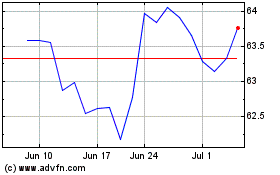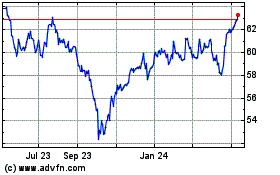Coke's Sales Volumes Grow -- WSJ
October 27 2016 - 3:03AM
Dow Jones News
Modest improvement reflects growth for noncarbonated drinks;
profit declines 28%
By Mike Esterl
Coca-Cola Co. sold more drinks in the third quarter after
volumes stalled earlier this year, lifted by noncarbonated
offerings and solid growth in the U.S., Japan and parts of Europe,
despite weakness in less-developed markets.
The beverage giant also said Wednesday it would continue efforts
to cut sugar from its products and diversify beyond soda as more
countries weigh special taxes on high-calorie drinks to combat
rising obesity and diabetes.
The maker of Coke, Minute Maid juices and Powerade sports drinks
reported volumes rose 1% in the third quarter, an improvement from
the second quarter, when volumes were flat for the first time since
1999. Revenue rose 3% in the most recent quarter after stripping
out bottling divestments and foreign-exchange losses.
Highlighting shifting consumer habits, soda volumes were flat,
including a 2% decline in Latin America. Noncarbonated volumes grew
3%, fueled mainly by bottled water and sports drinks.
North American revenue rose 3% as the company continues to roll
out smaller package sizes, charging consumers more on a per-ounce
basis. Noncarbonated volumes rose 2%, helped by a high-single-digit
percentage increase in Vitaminwater. Soda volumes were even, with
growth in Fanta and Sprite being offset by declines in Diet Coke as
Americans avoid artificial zero-calorie sweeteners.
Developed markets in Japan and Western Europe also grew but
emerging markets remain "a mixed bag" as economic and political
uncertainty weigh on results, Chief Executive Muhtar Kent told
analysts on an earnings call.
Management singled out the Latin American countries of Brazil,
Argentina and Venezuela as particularly challenging, despite
healthy growth in Mexico. Volumes also declined in India and
conditions in Russia remain difficult, offsetting healthy growth in
Nigeria and other parts of Africa.
Volumes rose 2% in China after declining the first six months of
the year, helped partly by better weather. Still, James Quincey,
Coke's chief operating officer, warned of "continued near-term
volatility" in the world's biggest marketplace amid a spending
slowdown. Coke has responded by launching smaller, cheaper package
sizes and scaling back the use of returnable bottles as more people
consume drinks in their homes instead of visiting restaurants.
Mr. Quincey said Coke also has more than 200 reformulation
initiatives under way across the world to reduce added sugars in
its beverages, including the use of stevia, a zero-calorie
sweetener. The company recently rolled out a variation of Sprite
with 30% fewer calories in the U.K., which plans to introduce a
sugary drink tax in 2018.
"We're making progress but we have a lot more to do," Mr.
Quincey told reporters on a conference call.
That also includes cutting Coke's reliance on soda, which
represents about 70% of company volumes, down from more than 90%
about 15 years ago. The portfolio mix has been shifting toward
noncarbonated drinks at a rate of roughly 1% a year and would take
another two decades to reach 50/50 at the current pace.
"I would certainly like to get there quicker than 20 years,"
said Mr. Quincey, who singled out dairy and plant-based beverages
as two areas that could see more bolt-on acquisitions.
Coke reported that revenue fell 6.9% to $10.63 billion in the
third quarter from $11.43 billion a year earlier. Structural items,
including bottling and distribution divestments, had a negative
impact of 8 percentage points. Weaker foreign currencies had a
negative impact of 2 percentage points.
Net income fell 28% to $1.05 billion, or 24 cents a share, from
$1.45 billion, or 33 cents a share, also weighed down by
restructuring costs and foreign currencies.
Still, Coke's results were slightly better than Wall Street
expectations and the company reiterated it expects pretax profit to
rise by 6% to 8% in 2016 after adjusting for structural items and
foreign-exchange losses.
Coke's share price was 0.1% lower at $42.49 in afternoon trade
on the New York Stock Exchange.
Write to Mike Esterl at mike.esterl@wsj.com
(END) Dow Jones Newswires
October 27, 2016 02:48 ET (06:48 GMT)
Copyright (c) 2016 Dow Jones & Company, Inc.
Coca Cola (NYSE:KO)
Historical Stock Chart
From Mar 2024 to Apr 2024

Coca Cola (NYSE:KO)
Historical Stock Chart
From Apr 2023 to Apr 2024
